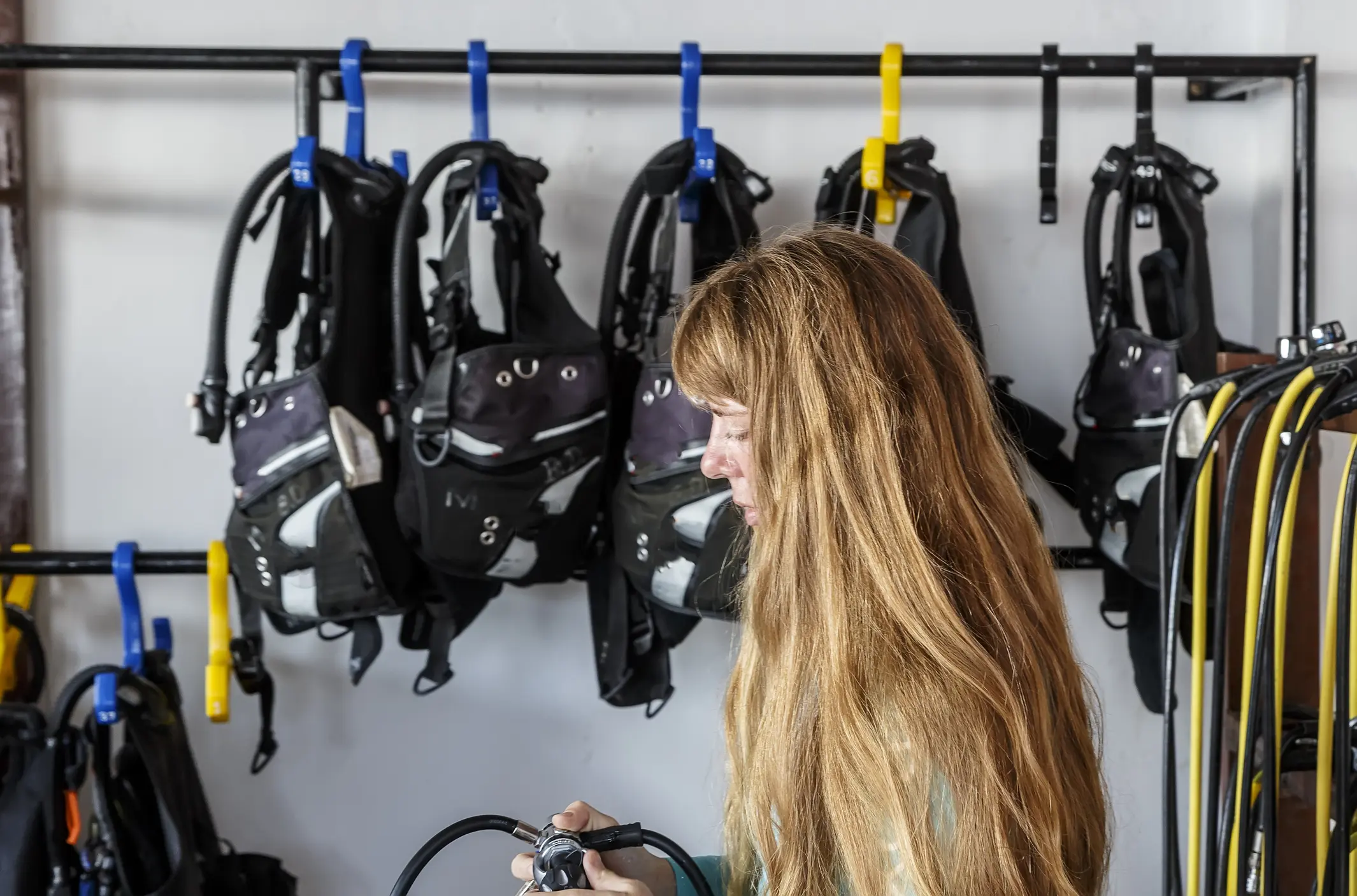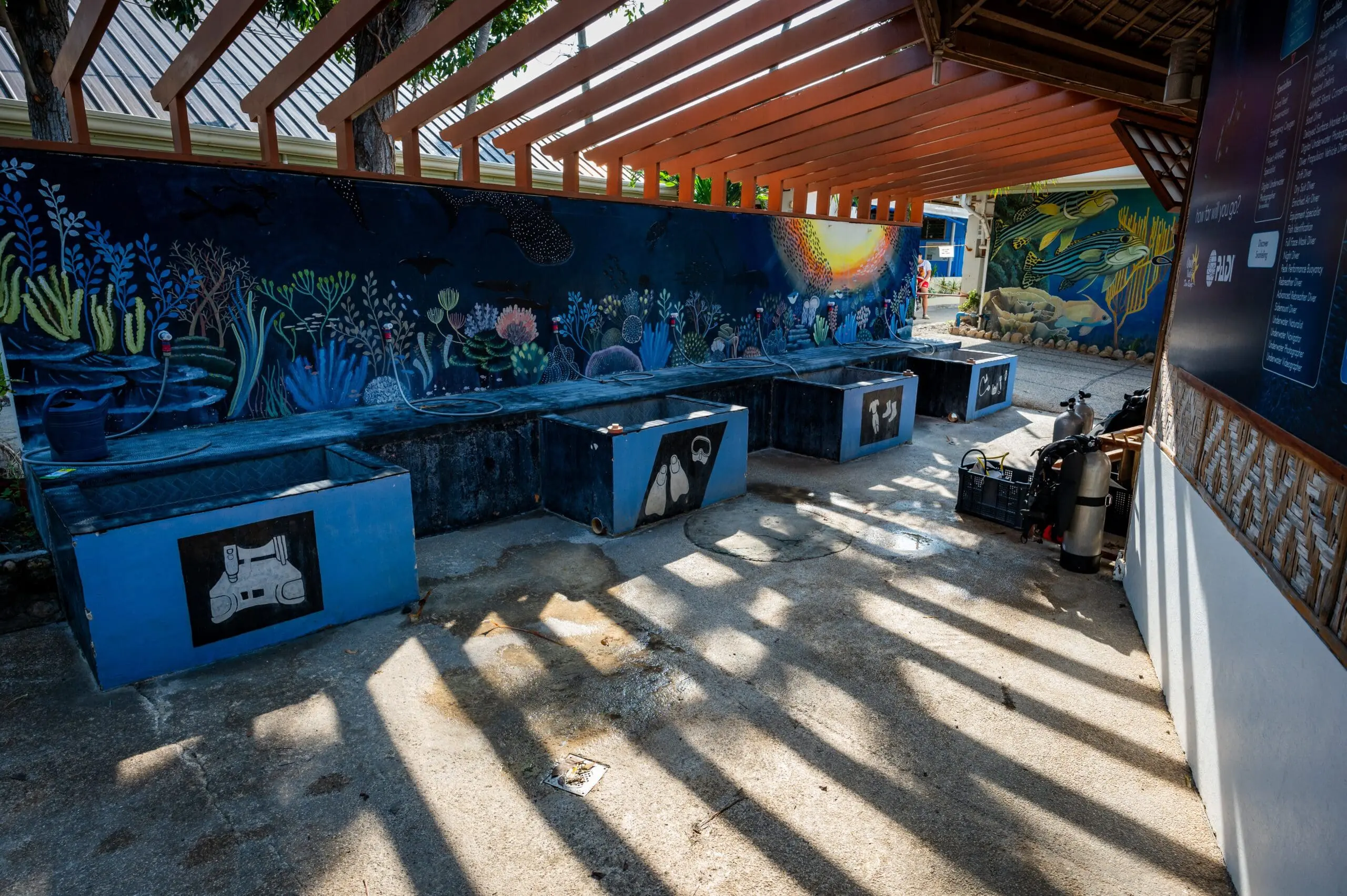How to Properly Care Your Diving Equipment – Key Tips
Purchasing your own diving gear is no doubt an investment. But one that comes with many rewards. By having your own dive gear, you can ensure that it fits, there’s no hassle and cost of renting the gear, it’s better performing and most importantly, it suits your preferences. All dive professionals tend to own all their diving gear if not parts of it. It’s part of the lifestyle that enables ease to dive more, learn more and get more out of diving. Especially favourable for PADI Divemasters in training.
Wondering what is the equipment needed for diving? Or maybe need an idea of what equipment to purchase for your Divemaster training? You can find a complete list of all the dive equipment here in our blog: What Diving Equipment Should I Own as a PADI Divemaster?

With owning dive gear, you also need to know how to take care of it. From knowing this, you can provide a great source of information to other divers especially as a PADI Divemaster in training. Another reason why owning your own dive gear at this level is beneficial. If you have previously undertaken a scuba diving course, you’ll know that cleaning diving equipment only in freshwater is important after a dive. This prolongs the use of the equipment dissolving salts/chlorine accumulated during a dive, helping to keep it in good working order and preventing potential costly large repairs/replacement.
Each piece of dive gear requires a certain technique to properly clean them. Below, we will go over each of these, including some tips and tricks to better maintain them and when to service them.
Buoyancy Control Device (BCD)
Here is a step by step guide on how to properly clean your BCD:
- 1
Firstly make sure the regulator has already been removed from the tank and any attachments e.g. torches, GoPros etc. have been unclipped and set aside. Then take the BCD off the tank.
- 2
Inflate your BCD manually around halfway (by holding down the deflate button on the inflator hose and breathing out into the BCD through the oral inflator mouthpiece).
- 3
Submerse the whole BCD in freshwater for a few seconds to clean the outside.
- 4To clean the inside, put freshwater into the BCD through the oral inflator mouthpiece whilst holding down the deflate button. You should fill the BCD around halfway with water.
- 5Once the BCD is fully filled with the water and air, shake the BCD so that the water rinses all inside areas.
- 6
Now fold the sides of the BCD inwards and holding to your chest, turn it upside down so that the inflator hose is pointing downwards and hold the deflate button to remove the water. Keep holding the button till all the air and water has been released.
- 7
Properly store your clean BCD, preferably hanging it in a drying room.
See our video below which runs through these points:
Tips and Tricks:
- 1
Avoid prolonged exposure of the BCD to direct sunlight or extreme heat. The nylon fabric of BCDs quickly fades if exposed to the sun’s UV rays for too long. Also extreme heat can damage the welded bladder seams.
- 2Keep it away from oil, gasoline, aerosols, or chemical solvents.
- 3
Do not allow the BCD to rub against any sharp objects or rough surfaces that could severely scratch or puncture the bladder. Do not put anything heavy on top of the BCD.
How often should I service my BCD?
You should get a professional inspection of your BCD every 2 years.
Primary regulator and alternate air source (Scuba regulator)
Here is a step by step guide on how to properly clean your Scuba regulator:
- 1
Firstly make sure the regulator is depressurised (by purging the alternate) and remove it from the scuba tank. Check if the dust cap is dry. If it isn’t, dry the dust cap (either with a dry t-shirt/towel or by blowing air from the tank onto it). Secure the dust cap to cover the regulator inlet.
- 2
Submerse only the hoses of the regulator in a container of freshwater leaving the first stage aside. Leave this in for a couple of minutes.
- 3
After, thoroughly clean the primary and alternate mouthpieces with freshwater, scrubbing them outside and inside. Give a quick rinse over the regulator hoses again paying attention particularly to the connections to the first stage.
- 4
Give the first stage a clean with freshwater avoiding the dust cap and regulator inlet.
- 5
Properly store your clean regulator, either by hanging it in a drying room or tidy in a clean equipment box.
See our video below which runs through these points:
Tips and Tricks:
- 1Avoid prolonged exposure to extreme heat, ozone, chlorine and ultraviolet rays which can degrade the rubber parts and components overtime.
- 2
Do not get it into contact with solvents and petroleum. Keep it away from aerosol which can damage the rubber and plastic components.
- 3
When cleaning the regulator, try not to accidentally press the purge buttons on each of the second stages. This can introduce unwanted moisture into the depressurised regulator. A build up of moisture could result in your regulator needing servicing.
How often should I service my Scuba regulator?
Every 12 months or every 100 dives.
As with the rest of the dive gear, make sure to rinse each piece well with freshwater after diving to prevent wear and tear from salt/chlorine. Also bear in mind that most dive centres have dedicated rinse buckets or containers for each particular equipment. As well as this, it’s always good practice to store equipment inside away from sunlight to prevent fading and degrading of materials.

Some additional tips to add are:
Exposure protection e.g. wetsuits/ rash guards
- 1
After a while, exposure suits / rash guards or any other dive clothing tend to smell a bit no matter how thorough you rinse them. It’s recommended that you soak it appropriately with an antibacterial cleanser e.g. Dettol every month or so.
- 2
Hang up dive clothing in a storage room after rinsing to prevent damp or mould.
Electronic devices e.g. dive computers, torches, compasses, dive cameras
- 1
Make sure to soak them sufficiently in freshwater (around 5 minutes) to fully dissolve salts/chlorine. This is to prevent any corrosion from happening in the device that could ultimately break it.
- 2
Ensure electronic devices are fully dry before storing it away. This prevents condensation from occurring which can lead to moisture damage.
- 3
If you have a dive torch, it is good to apply device lube onto the o-rings located on the threads of the battery screw. This ensures proper securement.
Fins and mask
- 1
Before wearing a new mask, properly scrub the inside of the lenses with toothpaste using your fingers. This is because in some cases, a small chemical layer builds up on the lenses during the manufacturing process. This needs to be removed to prevent your mask from fogging up underwater.
- 2
Store in a clean equipment box in a storage room.
There are no servicing requirements for these bits of dive gear. Should there be any damage to electrical devices, always send it to be repaired by a professional. Always monitor for damage and replace equipment accordingly.




